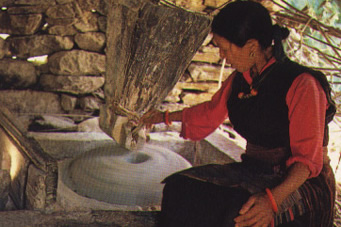 |
Nepal Development |
|
 |
Nepal Development |
|
|
 |
|
Traditional
water mill technology helps boost livelihoods
|
Sitting
in a tiny water mill, popularly known as a 'ghatta' in Nepalese, 65-year-old
farmer Ram Sharma waits for his customers to come with their wheat and
maize to grind flour for a small fee.
Sharma
built his 'ghatta' two years ago after he lost all his farmland and property
in flash floods that devastated Dhading village in Makwanpur District,
200km east of the capital, Kathmandu.
In
2006 floods affected over 50,000 people, including tens of thousands who
were made homeless. Nearly 2,000 animals were killed and over 10,000 tonnes
of food were destroyed, according to the Nepalese authorities.
Life
was already difficult for Sharma due to the decade-long armed conflict
with Maoist rebels, which had been adversely affecting his livelihood and
endangering the lives of civilians.
Sharma
took out a small loan and built his 'ghatta' at a time when civilians were
fleeing the villages and local non-governmental organisations (NGOs) were
unable to provide enough assistance to impoverished villagers, he said.
All
he needed was a tree trunk for the water runner, some timber to craft the
turbine wheel, a stone grinder and a convenient stream.
top
|
Family
fortunes on the up |
 |
 |
| Today,
the 'ghatta' has changed the life of his family. "This ancient rural technology
is helping my family," said Sharma happily.
Agreeing
with him, Sharma's 19-year-old grandson, Ramesh, said: "We had given up
all hope for our family's survival after we lost everything but all that
changed due to our grandfather's knowledge about the 'ghatta'". Ramesh
said his family was the first in Dhading to transform this local technology
into a business.
|
|
We
had given up all hope for our family's survival after we lost everything
but all that changed due to our grandfather's knowledge about the 'ghatta'.
Other
low-income villagers are now also following Sharma's example and building
their own 'ghattas'.
Sharma
also manages to trade his flour in villages and local urban markets. He
makes an additional income of nearly US$50 a month - a considerable sum
in the countryside, where gross national per capita income was $22.5 a
month in 2005 - according to the World Bank.
 |
|
Dil
Maya Tamang is another ghatta owner in nearby Basamari village where she
runs a successful business and can now afford to school all her five children.
"Our lives have changed a lot thanks to the 'ghatta' which is so easy and cheap
to build," said Tamang.
The
technology has been used for over a century, according to local NGO Centre
for Rural Technology (CRT), which has been helping to preserve and
promote 'ghattas' all around the country. |
|
"This
simple rural technology is being used especially by the poorest farmers
and is now becoming more popular in many remote villages, and opportunities
are growing after the peace accord," said Damodar Pokhrel, a local rural
technology expert.
top
|
Electricity
generation |
 |
Pokhrel
said there are nearly 100,000 'ghattas' all over the country but most needed
to be upgraded to make them more efficient. Traditional 'ghattas' can be
improved by upgrading the turbines and can be used not only for grinding
food grains but also for small-scale electricity generation in villages
off the national electricity grid, he added.
Efforts
to improve traditional 'ghattas' were started nearly 36 years ago by Swiss
engineer Andreas Bachmann who worked with Nepali small-hydro pioneers.
Several local organisations and manufacturers, especially CRT, Kathmandu
Metal Industries (KMI) and Nepal Yantra Shala (NYS) have followed up on
the technology and improved 'ghattas' throughout the country. CRT alone
has helped in the improvement of nearly 1,000 'ghattas' in over 40 districts
and helped nearly 50,000 families around the country.
"The
improved 'ghatta' can be very useful in electricity generation," said Nir
Lama, a local community leader in Daraune Pokhri village, where he and
local villagers have rebuilt their traditional mill into a multipurpose
power unit (MPPU), which now helps to generate electricity in their village.
Nearly
three years ago Lama raised funds among his fellow villagers to build the
MPPU. Today, the improved traditional 'ghatta' helps to generate electricity
and pump drinking water for nearly 100 households in the remote village.
"Improved
versions have brought about positive economic and social benefits by increasing
income and employment opportunities," said Shyam Pradhan, 'ghatta' expert
from Yantrasala Energy, which helps build improved 'ghattas'. He said the
initial investment is very small and the technology very simple.
In
a country with over 80 percent of the population dependent on agriculture,
the 'ghatta' is still the simplest, cheapest and most convenient way for
farmers to earn a living, according to the Alternative Energy Promotion
Centre (AEPC), a government organisation that has been actively involved
in the development of traditional rural technology.
International
aid agencies have also started to show active interest in supporting local
NGOs to expand improved water mill programmes all over the country, according
to CRT. Dutch government agency SNV (Netherlands Development Organisation)
has been investing heavily in this rural technology, said CRT.
Credit
IRIN 2007
Copyright
© UN Office for the Coordination of Humanitarian Affairs 2007
[
This report does not necessarily reflect the views of the United Nations] |
 |
Integrated
Regional Information Networks (IRIN), part of the UN Office for the Coordination
of Humanitarian Affairs (OCHA).
| Links |
 |
 |
 |
External
links |
top
|






